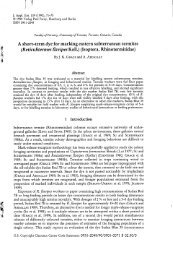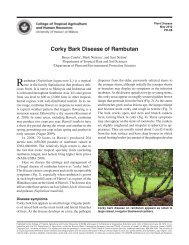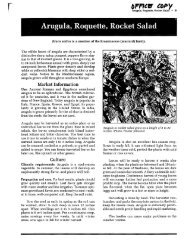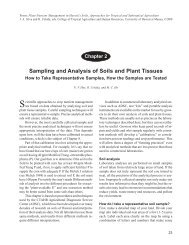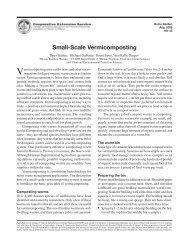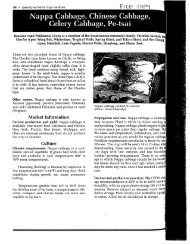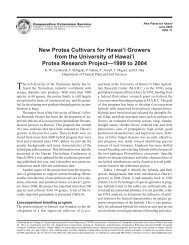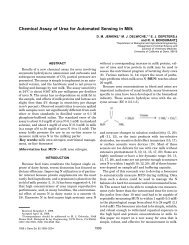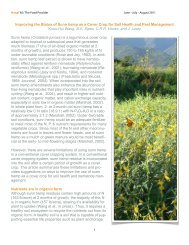Macadamia Nuts in Hawaii: History and Production - ctahr ...
Macadamia Nuts in Hawaii: History and Production - ctahr ...
Macadamia Nuts in Hawaii: History and Production - ctahr ...
You also want an ePaper? Increase the reach of your titles
YUMPU automatically turns print PDFs into web optimized ePapers that Google loves.
nut surface at room temperature to hold the salt.<br />
In roast<strong>in</strong>g, unevenly applied heat causes the<br />
surface of the kernel to brown rapidly while the<br />
<strong>in</strong>ner portion rema<strong>in</strong>s unroasted. Frequent stirr<strong>in</strong>g<br />
or agitation of nuts <strong>in</strong> oil roast<strong>in</strong>g, with an air<br />
blast <strong>in</strong> dry roast<strong>in</strong>g, is necessary to produce a uniform<br />
product. In spite of roast<strong>in</strong>g nuts as recommended,<br />
brown<strong>in</strong>g defects will appear on some<br />
kernels that appeared normal prior to roast<strong>in</strong>g.<br />
These are sorted <strong>in</strong>to lower grades. Good quality<br />
macadamia nuts, after roast<strong>in</strong>g, are light brown to<br />
tan. Kernel moisture content prior to cook<strong>in</strong>g is<br />
critical for the desired texture <strong>and</strong> stability. It has<br />
been shown that kernels with 1.4 percent moisture<br />
or lower produce nuts with good stability <strong>and</strong> only<br />
a slight decrease <strong>in</strong> q uality after 16 months of storage<br />
at temperatures up to 100°F. It has been also<br />
shown that kernels with moisture content exceed<strong>in</strong>g<br />
2 percent are not satisfactory for roast<strong>in</strong>g<br />
(3,12), much less storage.<br />
The oil used <strong>in</strong> roast<strong>in</strong>g goes through considerable<br />
chemical <strong>and</strong> physical changes with repeated<br />
use. Evidence gathered by Cavaletto <strong>and</strong><br />
Yamamoto (6) <strong>in</strong>dicated that the changes <strong>in</strong> oil<br />
quality over a period of 13 weeks' use did not affect<br />
flavor or shelf life appreciably. However, if desired,<br />
stability of nuts can be <strong>in</strong>creased by add<strong>in</strong>g the<br />
antioxidants butylated hydroxyanisole (BHA)<br />
<strong>and</strong> butylated hydroxytoluene (BHT) to the salt<br />
adhesive.<br />
Sta<strong>in</strong>less steel is recommended for the construction<br />
of vats, baskets, <strong>and</strong> any conta<strong>in</strong>ers used <strong>in</strong><br />
roast<strong>in</strong>g. Hot oil <strong>in</strong>troduces a corrosion problem<br />
with the use of other metal.<br />
Packag<strong>in</strong>g<br />
Premium grade roasted kernels are usually<br />
packed <strong>in</strong> cans, glass jars, or foil pouches, while<br />
commercial grade kernels are used for c<strong>and</strong>ies,<br />
brittles, chocolate-covered nuts, bakery products,<br />
ice cream, <strong>and</strong> so on (4). One enterpris<strong>in</strong>g manufacturer<br />
<strong>in</strong> <strong>Hawaii</strong> makes over 100 consumer<br />
products with macadamia nuts. More use of nuts<br />
<strong>in</strong> the confectionery trade is needed.<br />
MARKETING AND DISTRIBUTION<br />
The market<strong>in</strong>g <strong>and</strong> distribution of nuts to the<br />
consumer seem to be matters of sales philosophy,<br />
conceptual differences <strong>in</strong> market<strong>in</strong>g, <strong>and</strong> availability<br />
of funds to promote <strong>and</strong> sell products. This<br />
statement is especially true with large growers<br />
who see the total picture from grow<strong>in</strong>g <strong>and</strong> on<br />
68<br />
through to the grocery shelves, but must conf<strong>in</strong>e<br />
operations to a limited area because of their<br />
immediate <strong>and</strong> current money status. Except for<br />
one completely <strong>in</strong>tegrated company, the <strong>in</strong>dustry<br />
<strong>in</strong> <strong>Hawaii</strong> is made up of specialized companies<br />
<strong>and</strong> <strong>in</strong>dividuals who concentrate on the grow<strong>in</strong>g<br />
<strong>and</strong> production of <strong>in</strong>-shell nuts, the process<strong>in</strong>g to<br />
produce raw kernels, the process<strong>in</strong>g of roasted<br />
kernels for the grocery shelves, <strong>and</strong> the distribution.<br />
In time, depend<strong>in</strong>g on the size of operation<br />
<strong>and</strong> the <strong>in</strong>cl<strong>in</strong>ation of the <strong>in</strong>dividuals <strong>in</strong>volved,<br />
the companies may exp<strong>and</strong> <strong>in</strong>to the next category<br />
very easily. As the specialized companies become<br />
larger, no doubt the <strong>in</strong>tegration of the various<br />
production phases <strong>in</strong>to larger companies by<br />
merg<strong>in</strong>g or by expansion will happen. This tendency<br />
<strong>in</strong> growth is universal <strong>and</strong> very easily atta<strong>in</strong>ed<br />
when capital monies become available, or<br />
when the added production phase is simply an<br />
addition to an ongo<strong>in</strong>g procedure.<br />
The distribution of consumer products to the<br />
grocery shelves, on the other h<strong>and</strong>, is quite easy<br />
when the total volume is low, <strong>and</strong> possibly can be<br />
done by the processors themselves. But as the<br />
volume becomes larger, distribution becomes a<br />
specialized matter that might be h<strong>and</strong>led more<br />
efficiently by brokers <strong>and</strong> distributors. This is<br />
especially true when a large distributor is equipped<br />
to serve the whole country, with many items to sell<br />
at the same time to spread the distribution cost.<br />
THE FUTURE<br />
The <strong>Hawaii</strong> Agricultural Report<strong>in</strong>g Service <strong>in</strong><br />
the State of <strong>Hawaii</strong> released its annual summary<br />
sheet on macadamia nuts on January 19, 1982,<br />
partially repr<strong>in</strong>ted here as Table 4 (14). The<br />
summary <strong>in</strong>dicates that the 1981 <strong>in</strong>-shell nut<br />
production on farms was 36,000,000 pounds, compared<br />
with 20,980,000 pounds <strong>in</strong> 1978, for a 72<br />
percent <strong>in</strong>crease <strong>in</strong> production dur<strong>in</strong>g this period.<br />
The farm price dur<strong>in</strong>g this same period <strong>in</strong>creased<br />
by 23.2¢, or 43 percent, over that of 1978. Dur<strong>in</strong>g<br />
the same period, the wholesale price for the dried<br />
raw kernels from the factory <strong>in</strong>creased from $3.25<br />
to $4.75, or 46 percent, over that of 1978.<br />
Although <strong>in</strong>flation obviously had a part <strong>in</strong><br />
these price changes, a big real change <strong>in</strong> total production<br />
has taken place, <strong>in</strong>dicat<strong>in</strong>g that the marketability<br />
of the nuts will undoubtedly become the<br />
next problem <strong>in</strong> <strong>Hawaii</strong>.<br />
The Foreign Agricultural Service of the USDA<br />
reported on the production of macadamia nuts <strong>in</strong>



